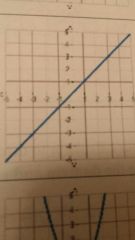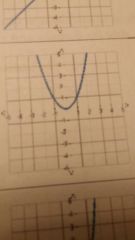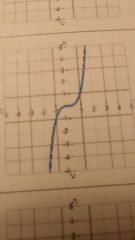![]()
![]()
![]()
Use LEFT and RIGHT arrow keys to navigate between flashcards;
Use UP and DOWN arrow keys to flip the card;
H to show hint;
A reads text to speech;
34 Cards in this Set
- Front
- Back
- 3rd side (hint)
|
F(c)= c |
Constant |

Straight line at whatever "c" is... |
|
|
F(x)= x |
Diagonal line |

Slope y=1 |
|
|
Y=b |
Horizontal line Slope is 0 Y intercept (0,b) |
If the graph intercepts only y axis then y is the only variable in the equation. |
|
|
x=a |
Vertical line Slope is undefined X intercept is (a,0) |
If the graph intercepts at only the x axis then x is the only variable in the equation. |
|
|
y-y'=m(x-x') |
Point slope form Slope is m Line passes through (x', y') |
|
|
|
Ax+By=C |
Standard Form Slope is -A/B (B can't equal 0) X intercept is (C/A,0) Y intercept is (0, C/B) |
|
|
|
Parallel lines |
SAME SLOPE |
|
|
|
Perpendicular lines |
INVERSE SLOPES |
|
|
|
Vertex |
Find x with x=-b/2a Then plug into given equation and solve for y. |
If different looking equation use (h,k) |
|
|
Given the Vertex and a point |
Substitute vertex and point into vertex form of a quadratic equation y=a(x-h)^2+k Solve for a Plug in only a and vertex into quadratic equation. |
|
|
|
Leading Coefficient is Positive and degree is even |
. Both sides upwards
|
|
|
|
Leading Coefficient is negative and degree is even |
Both sides face downwards
|
|
|
|
Degree is odd leading coefficient is positive |
then right hand up and left hand downwards |
|
|
|
Degree Odd leading coefficient is negative |
then right is down and left is up. |
|
|
|
F(x)=x^2 |
Domain: all real numbers Range: [0, infinity) |

|
|
|
F(x)=x^3 |
D: all real numbers R: all real numbers |

|
|
|
F(x)= sqr(x) |
D: [0, infinity) R: [0, infinity) |

|
|
|
F(x)=1/x |
D: (-infinity, 0) U (0, infinity) or all real numbers as long as x does not equal 0. R: (-infinity, 0) U (0, infinity) |

|
|
|
F(x)= abs(x) |
D: all real numbers R: [0, infinity) |

|
|
|
Vertical Asymptote |
Set bottom of equation ( denominator ) equal to zero and solve. |
|
|
|
Denominator |
Bottom of equation |
|
|
|
Numerator |
Top of equation |
|
|
|
Slant Asymptote |
Long division Denominator in front of numerator |
|
|
|
Symmetric to orgin |
You can flip equation and it will look the same. |
|
|
|
Symmetric to Y axis |
You can fold graph in half and still be good...from orgin. |
|
|
|
Degree of numerator less then degree of denominator |
Horizontal asymptote equal to 0 |
|
|
|
Degree of numerator is equal to that of denominator |
Horizontal asymptote is LC/LC |
|
|
|
Degree of Numerator greater then denominator |
Use slant asymptote |
|
|
|
Y intercepts |
Set x equal to zero |
|
|
|
X intercepts |
Set y equal to zero Usually factor |
|
|
|
Algebraically find VA |
Set denominator to zero |
|
|
|
Determine End behavior |
Degree and Leading coefficient. |
|
|
|
Find maximum point of object |
Find vertex -b/2a |
|
|
|
How many seconds for object to hit the ground? |
Set y equal to zero |
|

